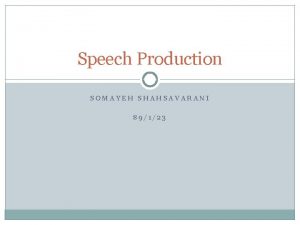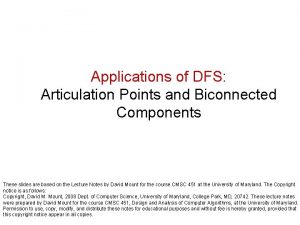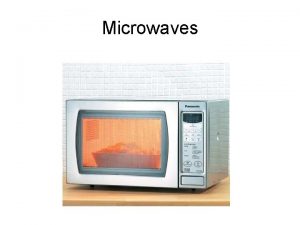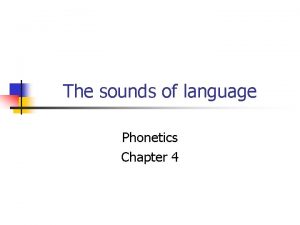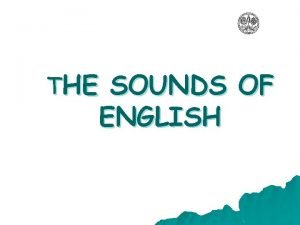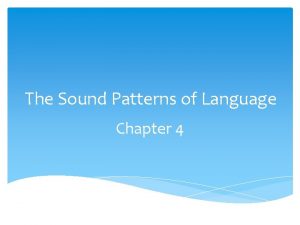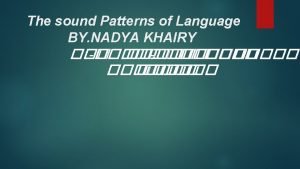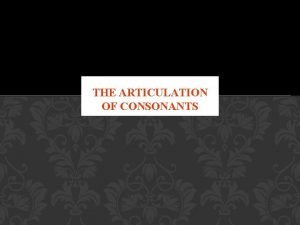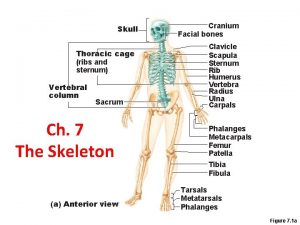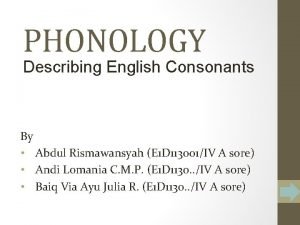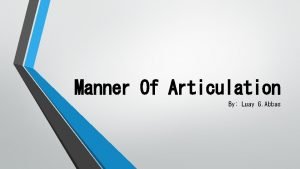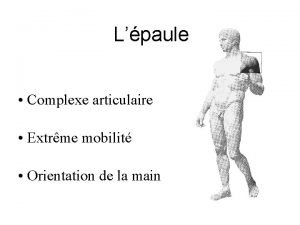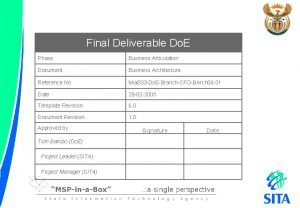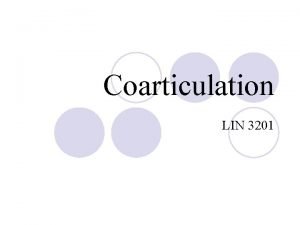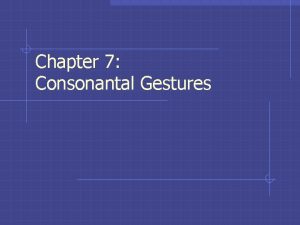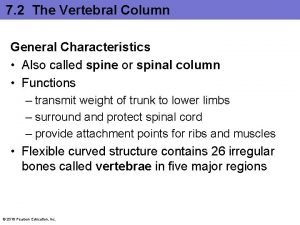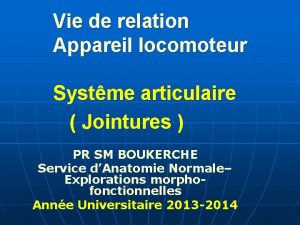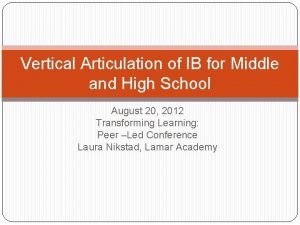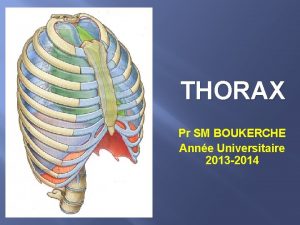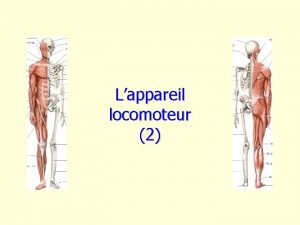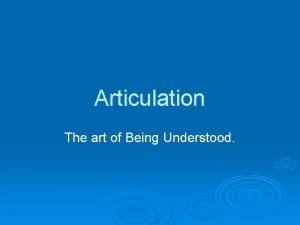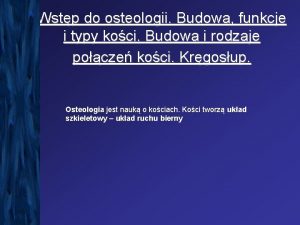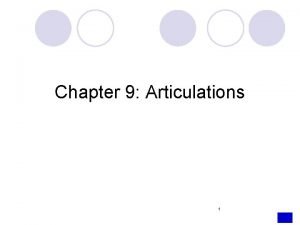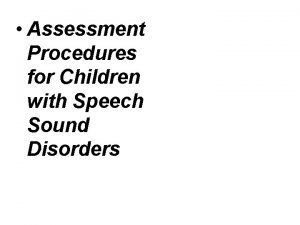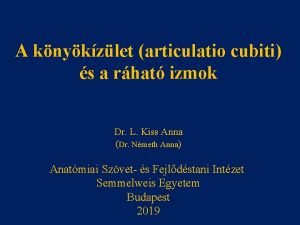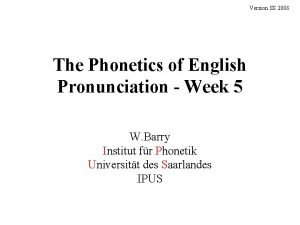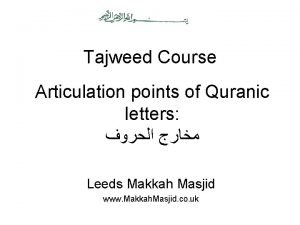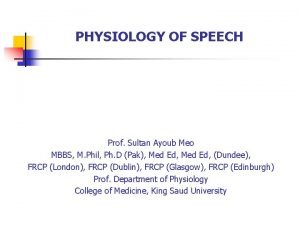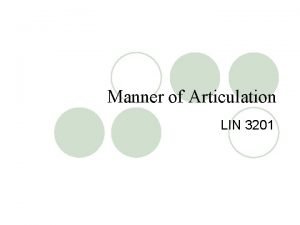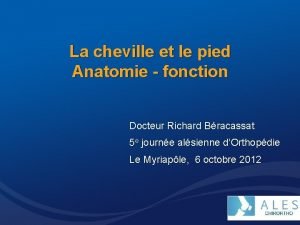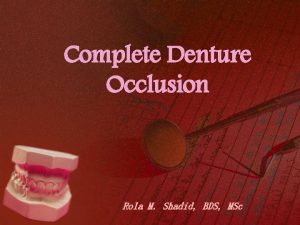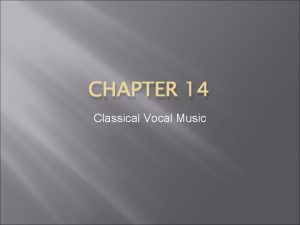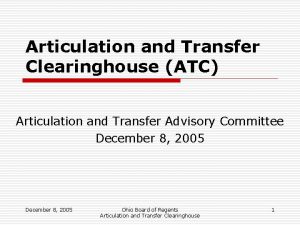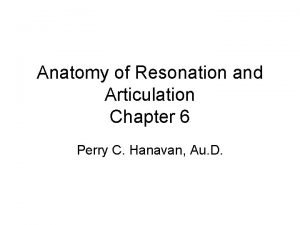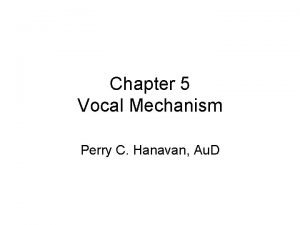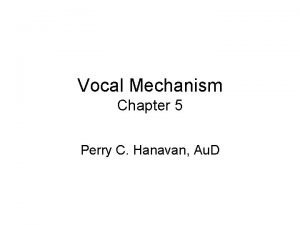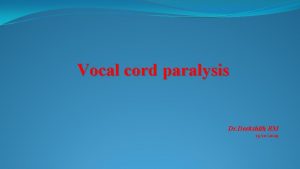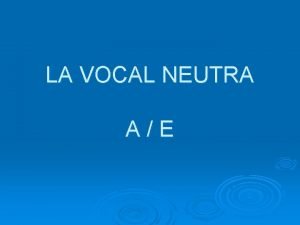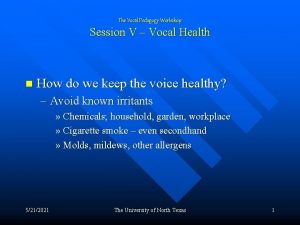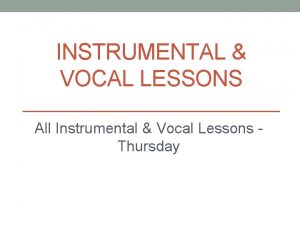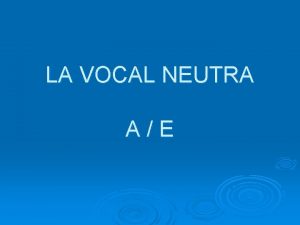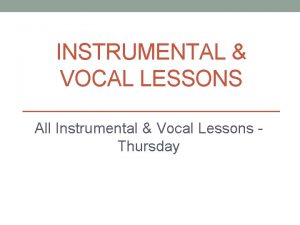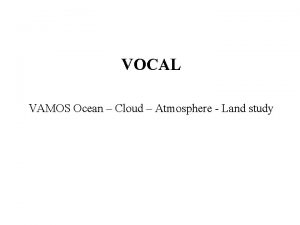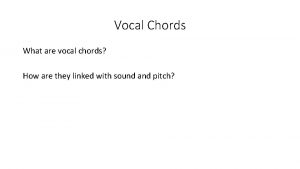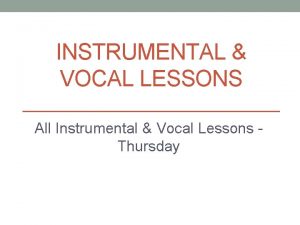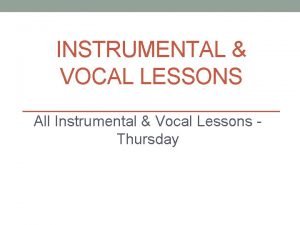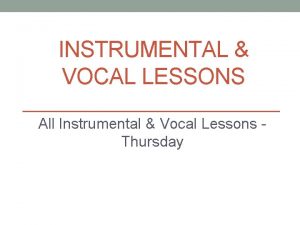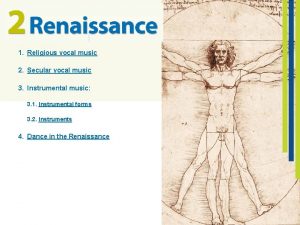Articulation and the Vocal Tract Chapter 3 Perry
































































































- Slides: 96

Articulation and the Vocal Tract Chapter 3 Perry C. Hanavan, Au. D. Audiologist

Oral Cavity • • • Anatomy Lips Oral cavity Teeth Hard palate Soft palate Uvula Tonsils Tongue

Question Which is not a part of the oral cavity? A. Uvula B. Soft palate C. Pharynx D. Lips E. Hard palate

Lips • Anatomy – FAS

Question Cupid bow is: A. Upper lip B. Lower lip C. Chin D. Nose E. A novel

Facial Muscles • Anatomy • Facial muscles

Question Which muscle helps round the lips? A. Obicularis oculi B. Obicularis oris C. Obicularis oracle D. Obicularis occipital

Teeth • Anatomy

Dental Occlusion • Types

Hard Palate • Anatomy – Oral cavity – Hard palate

Soft Palate • Anatomy

Tongue • Anatomy

Function of Soft Palate • Velopharyngeal port – nasality

Passavant’s Pad • A prominence on the posterior wall of the nasopharynx formed by contraction of the superior constrictor of the pharynx during swallowing. • Synonym: Passavant's bar, Passavant's pad, Passavant's ridge.

Speech Production • Phonemes (sound units of language) – Consonants (s, z) • Voiced (z) • Unvoiced (s) – Vowels (i) – Diphthongs (oy)

Production of Consonants • Place of production – Where major constriction occurs in vocal tract • Manner of production – How consonant is produced • Voicing (phonation) – Voiced or unvoiced

Place of Production • • Bilabial Labiodental Dental Alveolar Palatal Velar Glottal

Manner of Production • • • Stops Fricatives Africates Nasals Semivowels

Alphabet Soup 1. 2. 3. 4. 26 letters of alphabet Only list consonants Digraph consonants Other consonants

Glottal t d Velar Palatal Alveolar Inter. Dental Labiodental Bilabial p b k g Stops f v Ө s z h Fricatives Affricates m n w hw l r ŋ Nasals Semivowels j

Male Vocal Tract 17. 2 cm Tube open at one end, closed at the other ¼ Wave Resonator

Vocal Tract Resonators (Filter) • Tube open at both ends – ½ resonator • Tube closed at one end and open at the other – ¼ resonator

Vocal Tract (Filter) • Approximately 17. 2 cm for males • 5/6 the length for females • Children roughly half the length of adult male Assignment

Source-Filter Theory

Source-Filter Theory Fo (source produced at vocal folds) Formants (F 1, F 2, F 3, …) created by vocal tract resonance Source which is emphasized and not modulated by vocal tract resonance (F 1, F 2, F 3, shown at left)

Formants with Tongue Position More pictorials

Vowel Formants

Formants Created by Vowel Shapes

Vowel Formant Data

Adult Male Talker Data

Adult Female Talker Data

Chart Vowel Formants • Acoustics and Tongue Position • Video Clip

Lip Rounding

Vowels Formants

Source-Filter Theory

Vowel Spectrograph

Diphthongs

Consonants • Intensity (loudness cues) • Frequency (pitch cues) • Duration (length of sound cues)

Audiogram

Plotting Acoustic Data on Audiogram

Place of Production

Speech Production Patterns

Speech Production Patterns

Vowel Shapes

Spectrogram Dimensions

Spectrogram Dimensions

Transitions

Spectrogram Dimensions

Question What is the phoneme in the English language with the weakest energy? A. /l/ B. /r/ C. /s/ D. /f/ E. /ɵ/

Consonant Data

Intensity Data

Vowel Formants


Sound Source • Stops, fricatives and affricates produced in vocal tract as the sound source • For voiced stops, fricatives and affricates, there are two sound sources – Periodic laryngeal source combined with – Aperiodic vocal tract sound source • Aperiodic sound is produced by two different manners: – Sudden release of air pressure (burst/transient) behind closure • Stop/plosives – Turbulence as air rushes through a narrow constriction • fricatives

Stop/Plosive /p/ /b/ /t/ /d/ /k/ /g/

Manner of Production • Stops produced with – complete closure within the oral cavity, – build up of pressure behind the closure and – rapid release of closure with air rapidly expelled

Acoustic Events Divided into five components 1. Occlusion 2. Transient 3. Frication 4. Aspiration 5. Transition In practice, it is difficult to differentiate the transient from the frication, thus, this complex is generally referred to as the burst.

Acoustic Events • occlusion is the period during which there is a stoppage of the airflow during which the pressure increases. It is characterized by silence or the absence of energy. Voiced stops may have low frequency (0 - 500 Hz) periodic energy during this phase. • transient corresponds to the release of the closure. It is characterized by a spike on the spectrogram of intense energy with a duration of about 10 msec. • frication component is the result of the combination of high intra-oral pressure being released through a narrow opening at the point of release. • aspiration phase is the result of the vocal tract opening even further with turbulence through the glottis rather than the oral constriction. Formants are often present during this phase. • transition is the component where formants are present and the oral tract is moving to the position for the following vowel target. • In practice it is difficult to differentiate the transient from the frication so this complex is generally referred to as the burst.

ACOUSTIC CUES TO THE VOICED/VOICELESS DISTINCTION 1. 2. 3. 4. VOT F 1 of vowel following stop/plosive Preceding vowel duration Other cues

1. Voice Onset Time (VOT) • Voiced and voiceless stops differ in the coordination between supralaryngeal and laryngeal events – Difference is referred to as differences in Voice Onset Time (VOT) • Voice onset time is the time that voicing begins relative to consonant release • In English, voiceless stops have large VOT values and voiced stops have small or negative VOT values. – Negative VOT occurs when periodicity begins before stop release i. e. during closure • English speakers hear a consonant as voiceless if VOT is over 25 msec for bilabials, over 35 msec for alveolars and over 40 msec for velars • VOT values separating voiced from voiceless stops are language specific

1. Voice Onset Time (VOT) • Spanish and French make use of prevoiced stops (negative VOT) and contrast these with positive VOT stops. English does not recognize a difference between prevoiced and voiceless unaspirated • Thai speakers make a three way distinction for bilabials and alveolars. Voiced, voiceless unaspirated, voiceless aspirated • Values also change in context • VOT separation decreases for stops produced in sentences compared with initial stops produced in isolated words • Stressed voiceless are produced with greater VOT values than unstressed • VOT increases when stops occur in Stop Approximant sequences • VOT for unaspirated stops (/s. C/ clusters) is close to VOT for voiced stops in CV syllables

2. F 1 for Following Vowel • F 1 provides important acoustic information about voicing characteristics • F 1 is very low during complete closure. • For voiced stops-– F 1 rises very quickly from burst to vowel target formant position – Rise steepest in open vowels (high F 1), and flattest in close vowels (low F 1) • For voiceless stops – Periodicity (voicing) occurs at least 30 msec later than voiced stops so less of the formant will be pulse excited – By the time pulse excitation begins, F 1 has almost reached the vowel target • On spectrograms, voiced stops characterized by a voiced, rising F 1 transition which is NOT present in voiceless stops due to – pulse excitation begins later in the transition for voiceless stops – aspiration requires open glottis which (due to the large resonating sub laryngeal chamber) causes an attenuation of F 1 • For VC syllables— – F 1 should fall sharply into the closure for voiced stops – Offset frequency should be higher for voiced than voiceless stops

3. Preceding Vowel Duration • Duration of vowels before voiceless stops is shorter than before voiced stops. • 52 -69% shorter vowel duration before voiceless than voiced stops – Examples: Pop vs. Bob

4. Other • Voiced stops have voicing/periodicity during closure when in intervocalic or postvocalic position • Duration of intervocalic closure provides an additional cue to voicing • Closure greater for voiceless than voiced e. g. rapid vs. rabid • Onset frequency of Fo higher following voiceless than voiced stops. • Burst intensity of voiceless stops greater than voiced stop.

CHARACTERISTICS OF ENGLISH STOPS IN CONTEXT

Aspiration • When /p, t, k/ followed by /r, l, w, j/ aspiration manifests itself in the devoicing of the approximants "please", "try", "clean", "pew" • In final position and in unstressed syllables aspiration is weak • When /s/ precedes /p, t, k/ initially , there is no aspiration

Closure • /b, d, g/ only fully voiced during closure when occurring intervocalically

Release • Generally, stops have a release stage in the form of aspiration or as a following vowel. However, there are instances where the release does not occur • No audible release in final position: e. g. rope/robe • No audible release in stop clusters: e. g. dropped, locked, good boy • Glottal reinforcement of final voiceless stops: – Nasal release: If a stop is followed by a homorganic nasal in the following syllable, the release of air is usually via the nasal cavity. e. g. topmost, submerge, cotton, not now, red nose – Lateral release: When the homorganic stops /t, d/ occur before /l/ they are released laterally. The tip remains in contact with the alveolar ridge but one or both of the sides is lowered allowing the air to escape. e. g. cattle, medal, atlas

Place of Production • Place of articulation for stops determined by 1. burst 2. transitions

Burst • Burst is combination of transient and frication phase – Provide information for place of production – Frequency spectrum for alveolars and velars results from resonance of cavity in front of tongue constriction • Alveolars--front cavity is small and place of production doesn't alter greatly under influence of different vowels • Velars, front cavity shape varies greatly with different vowels • Three important parameters of burst that allow one to differentiate the place of production of stops: – – – Energy level Spectral centre of gravity (frequency location of main energy concentration) Spectral variance (whether the spectrum lacks peaks or has multiple peaks)

1. Energy Level • Alveolar stops have the most intense bursts • Bilabials have weakest bursts – Due to lack of resonance for bilabials as no front cavity to amplify the sound • Little difference between alveolar and velar

2. Center of Gravity • Bilabials lack any main resonance in the 0 -10 k. Hz range as there is no front cavity so characterized by gradually falling distribution of energy throughout frequency range • Alveolars - broad distribution of energy in the burst characterized by prominence about 1. 8 k. Hz and another rise between 2. 5 -4. 5 k. Hz • Velar - compact concentration of energy in middle of spectrum which varies according to F 2 and F 3 of following vowel • Frequency position of energy for velars derives from the cavity in front of tongue constriction • Prevelar (before front vowels (/kip/, /gis/), compact energy distributed around center frequency of about 3 k. Hz • Postvelar (before back vowels(/ko: t/, /go: d/) compact energy distributed around center frequency of about 1 k. Hz • High frequency bursts = alveolar 3 k. Hz to 4 k. Hz • Low frequency bursts = bilabial 350 Hz (but higher for front vowels) • Bursts with energy slightly above the F 2 for the following vowel = velar e. g back vowels = low F 2 : 700 Hz, front vowels high F 2: 3 k. Hz

3. Formant Locus & Transitions • The locus theory proposes that the place of articulatory closure for each of the three places of articulation is relatively fixed regardless of following vowel and that this articulatory invariance has its acoustic correlate in the starting frequency of the second formant. Even though the formants may not reach the actual locus position they will still point to it. • Once we know the locus frequency we should be able to predict the slope of the second formant transition if we know the following vowel formant frequencies. • Therefore: The locus for /b/ is low (720 Hz) and most vowels would have an F 2 value greater than that then the transition will be rising in /b. V/ syllables. • The locus for /d/ being at 1800 Hz means that for central and back vowels F 2 will fall in /d. V/ syllables but will be level or slightly rising in /di, d. I, de/. • Only the alveolars can be considered to have a relatively stable locus at around 1800 Hz. Cassidy and Harrington (1994) found that the variability in F 2 onset frequency is least for /d/ followed by /b/ then /g/.

3. Formant Locus & Transitions • For bilabials and velars, there is not an invariant locus value as modifying following vowel will produce large changes in formant frequency values – For instance, for bilabials F 2 and F 3 will have rising transitions before front vowels but F 2 will be falling before back vowels • When F 3 information is included, better picture of how the stops cluster • F 2/F 3 plots show tendency of three clusters corresponding to bilabial, alveolar and velar – However there are examples of bilabials which are potentially confusable with velars preceding back vowels – If we examine the change in F 2 relative to the change in F 3 (the difference between the formant value at onset and the value at the vowel target) then these bilabials are well separated • Cannot separate place of articulation on just one dimension such as F 2 locus. – Several variables are required to give the whole picture • Locus is not invariant as it changes substantially as a result of coarticulation

Stops Produced with a closure within the oral cavity, a build up of pressure behind this closure and a release of the closure allowing the air to be rapidly expelled. Acoustically these events can be divided into five components: 1. Occlusion 2. Transient 3. Frication 4. Aspiration 5. Transition More info

Plosives Manner of Production

Fricatives

Fricatives Fricative production involves two articulators being brought together and held close enough for the escaping air to become turbulent creating an aperiodic (noise) sound. Maybe be voiced or unvoiced. The closure phase of fricatives is characterized by the continuant noisy aperiodic component. The characteristics of the noise are the result of the position of the constriction, the shape of the orifice, and the aerodynamic forces of the air stream. Acoustic characteristics include: High frequency hiss, long duration, weak to moderate intensity

Unvoiced Fricatives

Sliding from /s/ to /ʃ/

Affricates • Stop with a fricative release – but palatal. • Combination of stop and fricative characteristics. • Closure, burst followed by short silence then frication. • Affricates have shorter rise time than fricatives. – Rise time is the time from onset to peak intensity of frication. • Affricates distinguished from fricatives by presence of closure and by duration of noise which is longer for fricatives. • Shorter the duration of noise, shorter the silence necessary to elicit affricate response.

Affricates

Question Which consonants are characterized by antiresonants? A. Plosives B. Fricatives C. Affricates D. Nasals E. Semivowels

Nasals • Like the oral tract, nasal tract has its own resonant frequencies or formants. • Most commonly reported nasal formants occur at 300 Hz, 1 k. Hz, 2. 2 k. Hz, 2. 9 k. Hz, 4 k. Hz. • Antiresonances enter whenever there is a side branch in the main acoustic pathway. • An antiresonance or zero serves to decrease the spectral energy at specific frequencies by absorbing the sound at or near the antiresonant frequencies. These cumulatively have effect of reducing the total amplitude of the sound generated.

Nasals

Formants / Antiformants

Nasal Antiformant

Approximates (Semivowels) Approximants are consonants most similar to vowels in their articulation and hence their acoustic structure. Articulation involves one articulator approaching another but without the tract becoming narrowed to such an extent that turbulent airflow occurs. Like vowels, approximants are: • highly resonant • produced with a relatively open vocal tract • characterized by identifiable formant structures • continuant sounds since there is no occlusion or momentary stoppage of the air stream • non turbulent due to lack of constriction • voiced sounds

Semivowels

Question Which of the following are glides? A. l B. r C. j D. w E. A and B F. C and D

l and r

Glides

VOT

Connected Speech

Place of Production Cues

Manner of Production
 False and true vocal cords
False and true vocal cords What are the two vocal styles of singing in pakistan
What are the two vocal styles of singing in pakistan Pyramidal vs extrapyramidal tract
Pyramidal vs extrapyramidal tract Rubrospinal tract
Rubrospinal tract Dualism multiplicity and relativism
Dualism multiplicity and relativism Matt thiessen
Matt thiessen Arytnoids
Arytnoids Curve of monson definition
Curve of monson definition Phonation and articulation
Phonation and articulation Phonation and articulation
Phonation and articulation Articulation points and biconnected components
Articulation points and biconnected components Kalani perry
Kalani perry Perry glasser
Perry glasser Words that rhyme with courage
Words that rhyme with courage Dr perry neurologist
Dr perry neurologist Figurative language in roar
Figurative language in roar Chapter 18 apush
Chapter 18 apush Reece map
Reece map William g perry
William g perry Who was perry
Who was perry Sunrise sunset swiftly fly the years
Sunrise sunset swiftly fly the years Idioms in roar by katy perry
Idioms in roar by katy perry Perry laroque
Perry laroque Dr. perry sugar
Dr. perry sugar Perry grigsby
Perry grigsby Daimyo definition ap world history
Daimyo definition ap world history Katy perry firework figurative language
Katy perry firework figurative language Brian perry lawyer
Brian perry lawyer Importance of the study example
Importance of the study example Perry high school marching band
Perry high school marching band Dog spay perry county
Dog spay perry county Perry babb
Perry babb Patrick geddes
Patrick geddes Dr perry liu
Dr perry liu Dr richard perry neurologist
Dr richard perry neurologist Bill perry designs
Bill perry designs Josie perry sports psychologist
Josie perry sports psychologist Gabby perry
Gabby perry Kuhn perry
Kuhn perry American enterprise institute
American enterprise institute Perry zinn rowthorn
Perry zinn rowthorn Jason perry md
Jason perry md What are sanctions
What are sanctions Balamory painter
Balamory painter Perry high school marching band
Perry high school marching band Perry aritua
Perry aritua Mark perry brunel
Mark perry brunel Ut tyler letter of appreciation
Ut tyler letter of appreciation Perry meridian middle school
Perry meridian middle school Double articulation
Double articulation Language
Language Vdoe vertical articulation
Vdoe vertical articulation Articulation costo-corporéale
Articulation costo-corporéale Phonetics and phonology
Phonetics and phonology Place of articulation
Place of articulation Vowel sounds with examples
Vowel sounds with examples Co-articulation
Co-articulation Co-articulation
Co-articulation Place of articulation consonants
Place of articulation consonants Thoracic cage anterior view
Thoracic cage anterior view Quoll pronunciation
Quoll pronunciation Indiana math framework
Indiana math framework Manner of articulation
Manner of articulation Bilabial phonemes
Bilabial phonemes Manner of articulation definition
Manner of articulation definition Adduction abduction
Adduction abduction Double articulation
Double articulation Gustilo anderson clasificacion
Gustilo anderson clasificacion Articulation in solution design document
Articulation in solution design document Vertical articulation example
Vertical articulation example Coarticulation in phonetics
Coarticulation in phonetics Laminal sounds
Laminal sounds Consonants place of articulation
Consonants place of articulation Talocrurale
Talocrurale Rib cage labeled
Rib cage labeled Articulation sphéroide
Articulation sphéroide Vertical articulation template
Vertical articulation template Articulation interchondrale
Articulation interchondrale Cranium
Cranium Lappareil locomoteur
Lappareil locomoteur Gliding vowels
Gliding vowels Articulation letter writing
Articulation letter writing Mityczny dźwigacz nieba
Mityczny dźwigacz nieba Incisal guidance angle
Incisal guidance angle The arrangement of element of curriculum is known as
The arrangement of element of curriculum is known as What is an articulation point on a bone
What is an articulation point on a bone Life-situations design
Life-situations design Caap articulation test
Caap articulation test Art radioulnaris proximalis
Art radioulnaris proximalis Wrist flexors
Wrist flexors Manner of articulation
Manner of articulation Tongue articulation
Tongue articulation Articulation mechanism
Articulation mechanism Mode of articulation
Mode of articulation Mortaise anatomie
Mortaise anatomie Manner of articulation
Manner of articulation Incisal guidance
Incisal guidance








